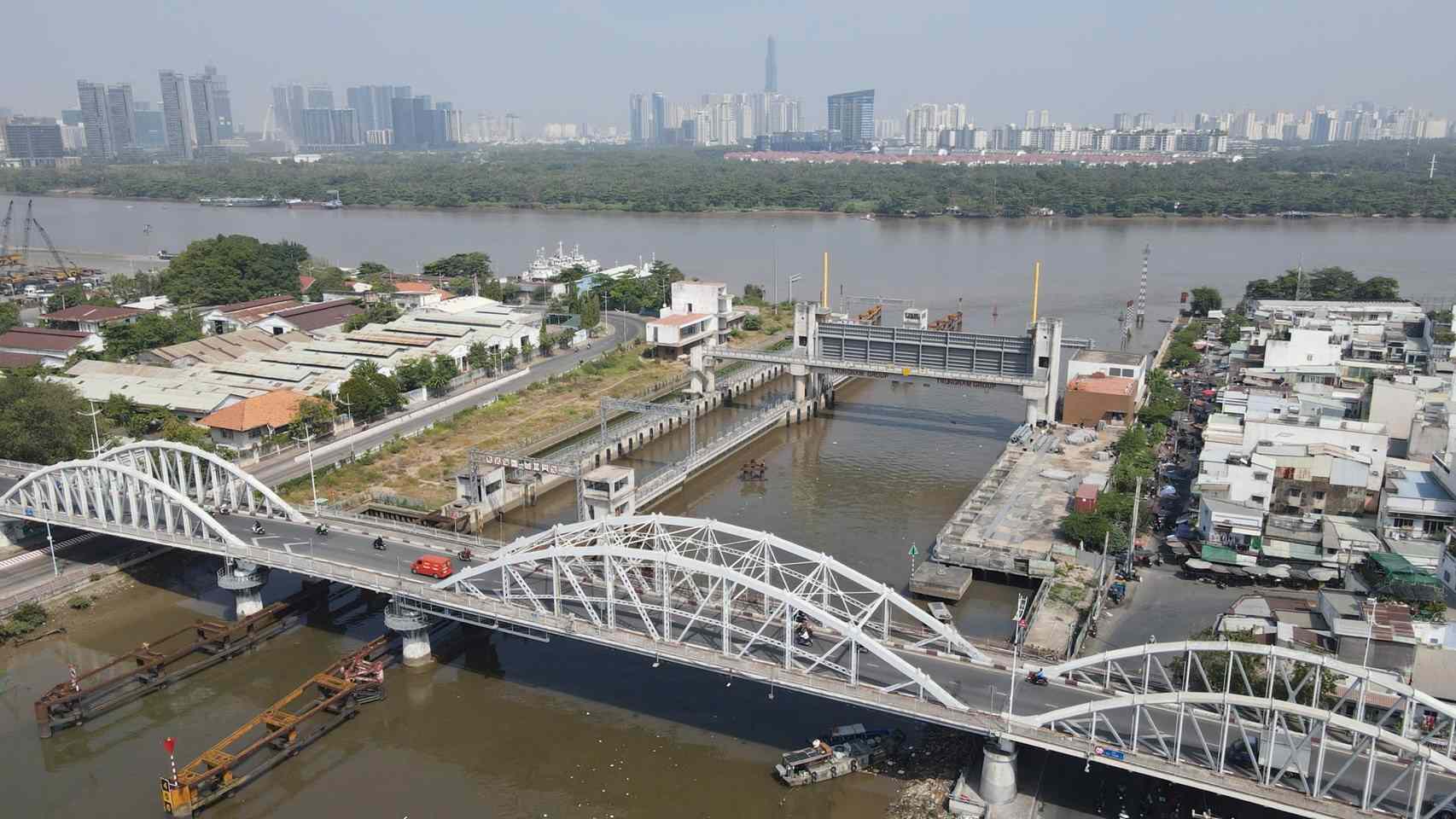Living with high tides next to a 10,000 billion VND flood prevention project
On Dinh An Tai Street (Phu Dinh Ward), people are very familiar with the scene of high tides overflowing the bank. Not far from their house is the Phu Dinh tidal sluice project - a project of the VND10,000 billion tidal prevention project, now exposed to the sun and rain in the middle of the Doi Canal.
"Every 5 years I have to buy 2 new pumps. Sand is piled up in front of the door to prevent water, every night when the tide rises, we have to stay up watching" - Mr. Mai Van An (55 years old) sighed. For Mr. An, the story of rising water and flooding houses has become an unwanted habit. The works of the royal court right next to the house, once a hope, are now just a disappointment.
Phu Dinh culvert is located at the confluence between Can Giuoc river, Cho Dem river and Tau Hu - Ben Nghe canal, considered the "gateway" to the overflow from Vam Co Dong river into the inner city. But the Phu Dinh wharf area is already low-lying, densely populated, just a high tide will cause water to immediately overflow onto the road surface, seeping into each house.
Not only in Phu Dinh, flooding also recurred in many other places. At Thu Duc market, Vo Van Ngan, Duong Van Cam, To Ngoc Van, Kha Van Can streets are often submerged in water during heavy rains. The water from many directions caused the sewer covers to splash, the road surface to crack, traffic to be paralyzed, and business to stagnate.
In the Go Vap area, heavy rain caused a series of roads such as Pham Van Chieu, Le Duc Tho, Nguyen Van Khoi to turn into rivers.
Ho Chi Minh City is a special urban area with more than 14 million people (after merging with Binh Duong, Ba Ria - Vung Tau) that is increasingly sinking into prolonged flooding.
According to Prof. Dr. Le Huy Ba, Ho Chi Minh City is currently a "semiconductor city", affected by both extreme rain and high tides. Despite spending tens of thousands of billions of VND on a series of projects, the city is still struggling with the problem of flooding.
Mr. Le Huy Ba said that since 2001, Ho Chi Minh City has had Plan 752, then Plan 1547 in 2008, aiming to build more than 6,000 km of drainage culverts, 103 regulating lakes, 170 km of dykes and 12 culverts to prevent major tides. But up to now, only about 60% of the sewer system has been completed, while the regulating lakes are almost still on paper.

Waiting for solutions to "revive" the project
The Ho Chi Minh City tidal flood resolution project takes into account climate change factors - phase 1 started in 2016, with Trung Nam Construction Investment Joint Stock Company as the investor under the BT (build - transfer) form.
The project includes 6 tidal control sluices (Ben Nghe, Tan Thuan, Phu Xuan, Muong Chuoi, Cay Kho, Phu Dinh) and a 6km long dike along the Saigon River, expected to be completed in 2018 to control flooding for 570km - with 6.5 million people in the central and southern areas of Ho Chi Minh City. However, despite reaching more than 90% of the volume, the project has been stalled since 2020 due to legal problems and no agreed land fund for payment, causing a series of degraded items, and people around the area are still flooded every day.
On July 21, 2025, the Government issued Resolution 212/NQ-CP, allowing Ho Chi Minh City to adjust the feasibility study report and pay land funds to investors, paving the way for the project to be restarted, completed and put into operation in 2026. The project working group proposed that the Ho Chi Minh City People's Committee approve 5 land plots for payment, with a total value of more than VND 8,099 billion, equivalent to 81.1% of the value of the BT contract. These plots of land are currently waiting for Ho Chi Minh City leaders to approve as a basis for signing the BT contract appendix to restart the project.
A representative of Trung Nam Group said that adding land funds is a prerequisite to help remove obstacles, complete and put the project into operation soon. If the procedures continue to be delayed, the project will be prolonged and wasteful, while the additional costs are huge - the loan interest alone is estimated at more than 1.7 billion VND per day since the suspension at the end of 2020.
According to Associate Professor, Dr. Ho Long Phi - former Director of the Center for Water Management and Climate Change (Ho Chi Minh City National University), to effectively control flooding, the city needs to synchronize many solutions: Build dykes, river embankments, tidal culverts and large-capacity pumping stations; at the same time, develop a network of regulating lakes, clear canals to dispers the flow.
In the immediate future, Ho Chi Minh City needs to prioritize the completion of unfinished projects, especially the 10,000 billion VND tidal prevention project, which has reached more than 90% of the volume. When put into operation, this project will contribute significantly to helping control flooding in the central and southern areas of the city," Mr. Ho Long Phi emphasized.











